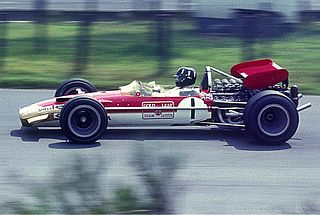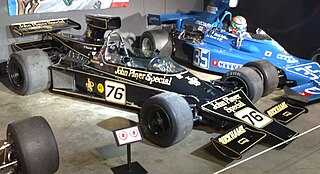
Anthony Colin Bruce Chapman was an English design engineer, inventor, and builder in the automotive industry, and founder of the sports car company Lotus Cars.

The 1978 Swedish Grand Prix was a Formula One motor race held on 17 June 1978 at the Scandinavian Raceway. It was the eighth race of the 1978 World Championship of F1 Drivers and the 1978 International Cup for F1 Constructors, and the last Formula One Swedish Grand Prix to date.

The 1979 Formula One season was the 33rd season of FIA Formula One motor racing. It featured the 1979 World Championship of F1 Drivers and the 1979 International Cup for F1 Constructors which were contested concurrently over a fifteen-round series which commenced on 21 January 1979, and ended on 7 October. The season also included three non-championship Formula One races.

The Lotus 78 was a Formula One racing car used in the 1977 and 1978 seasons. It was designed by Peter Wright, Colin Chapman, Martin Ogilvie and Tony Rudd, and was the first ground effect car in Formula One.

Team Lotus was the motorsport sister company of English sports car manufacturer Lotus Cars. The team ran cars in many motorsport categories including Formula One, Formula Two, Formula Ford, Formula Junior, IndyCar, and sports car racing. More than ten years after its last race, Team Lotus remained one of the most successful racing teams of all time, winning seven Formula One Constructors' titles, six Drivers' Championships, and the Indianapolis 500 in the United States between 1962 and 1978. Under the direction of founder and chief designer Colin Chapman, Lotus was responsible for many innovative and experimental developments in critical motorsport, in both technical and commercial arenas.

The Lotus 49 was a Formula One racing car designed by Colin Chapman and Maurice Philippe for the 1967 F1 season. It was designed around the Cosworth DFV engine that would power most of the Formula One grid through the 1970s. It was one of the first F1 cars to use a stressed member engine combined with a monocoque to reduce weight, with other teams adopting the concept after its success. An iteration of it, the 49B, also pioneered the use of aerofoils to generate downforce.

The Brabham BT46 is a Formula One racing car designed by Gordon Murray for the Brabham team, owned by Bernie Ecclestone, for the 1978 Formula One season. The car featured several radical design elements, one of which was the use of flat panel heat exchangers on the bodywork of the car to replace conventional water and oil radiators. It was removed before the car's race debut, never to be seen again. The cars, powered by a flat-12 Alfa Romeo engine, raced competitively with modified nose-mounted radiators for most of the year, driven by Niki Lauda and John Watson, winning one race in this form and scoring sufficient points for the team to finish third in the constructors' championship.

The Lotus 79 is a Formula One car designed in late 1977 by Colin Chapman, Geoff Aldridge, Martin Ogilvie, Tony Rudd, Tony Southgate and Peter Wright of Lotus. The Lotus 79 was the first F1 car to take full advantage of ground effects aerodynamics.

The Lotus 88 is an innovative Formula One car designed by Colin Chapman, Peter Wright, Tony Rudd and Martin Ogilvie of Lotus in an effort to maximise the downforce produced by ground effect. The Lotus 88 made its debut at the first practice session of the 1981 season opener, the US Grand Prix West at Long Beach. Although the Lotus 88 was not allowed to race, it was the first Formula One car to use a carbon fibre monocoque chassis and debut at a Grand Prix event. The carbon fibre McLaren MP4 made its first appearance at the third Grand Prix of the season in Argentina.

The Williams FW07 was a ground effect Formula One racing car designed by Patrick Head, Frank Dernie, and Neil Oatley for the 1979 F1 season.

The Ferrari 126C is the car with which Ferrari raced from the 1981 through the 1984 Formula One season. The team's first attempt at a turbocharged Formula 1 car, it was designed by Mauro Forghieri and Harvey Postlethwaite. The engine chief engineer was Nicola Materazzi.

The Lotus 76 is a Formula One car designed by Colin Chapman, Tony Rudd and Ralph Bellamy and used by Team Lotus in the 1974 Formula One season.

The Lotus 77 was a Formula One racing car designed by Colin Chapman, Geoff Aldridge and Martin Ogilvie for the 1976 Formula One season.
In car design, ground effect is a series of effects which have been exploited in automotive aerodynamics to create downforce, particularly in racing cars. This has been the successor to the earlier dominant aerodynamic focus on streamlining. The international Formula One series and American racing IndyCars employ ground effects in their engineering and designs. Similarly, they are also employed in other racing series to some extent; however, across Europe, many series employ regulations to limit its effectiveness on safety grounds.

The Lotus 81 was a Formula One racing car built by Colin Chapman's Lotus team for the 1980 Formula One season. Unlike many of forebears the 81 was not a terribly innovative or competitive car, coming as it did at a time when Chapman's interest in his racing activities was waning.

The BRM P126 was a Formula One racing car which raced in the 1968 and 1969 Formula One seasons. It was powered by a 3.0-litre V12 engine. Design was contracted out to former Lotus and Eagle designer Len Terry and the three examples built were constructed by his Transatlantic Automotive Consultants company due to pressure of work at BRM.

The Williams FW was a Formula One car used by Frank Williams Racing Cars during the 1973, 1974 and 1975 seasons. It was designed by John Clarke.

The Fittipaldi FD was a series of Formula One chassis designed by Richard Divila and used by Fittipaldi Automotive in the 1975, 1976 and 1977 seasons. The initial chassis was designated Fittipaldi FD01 and there were three minor developments designated, Fittipaldi FD02, Fittipaldi FD03 and Fittipaldi FD04 respectively. FD series cars competed in 37 races making 43 individual entries in total. The chassis achieved a best finish of fourth place at both the 1977 Argentine and Brazilian Grands Prix driven on each occasion by former World Champion and joint team-owner Emerson Fittipaldi. It scored a total of 11 World Championship points.

The Surtees TS19 was a Formula One (F1) car used by Surtees during the 1976, 1977 and 1978 F1 seasons. It was designed by John Surtees and Ken Sears.
The Parnelli VPJ4 was a Formula One racing car designed by Maurice Philippe, and used by Vel's Parnelli Jones Racing during the 1974, 1975 and 1976 Formula One seasons.




















